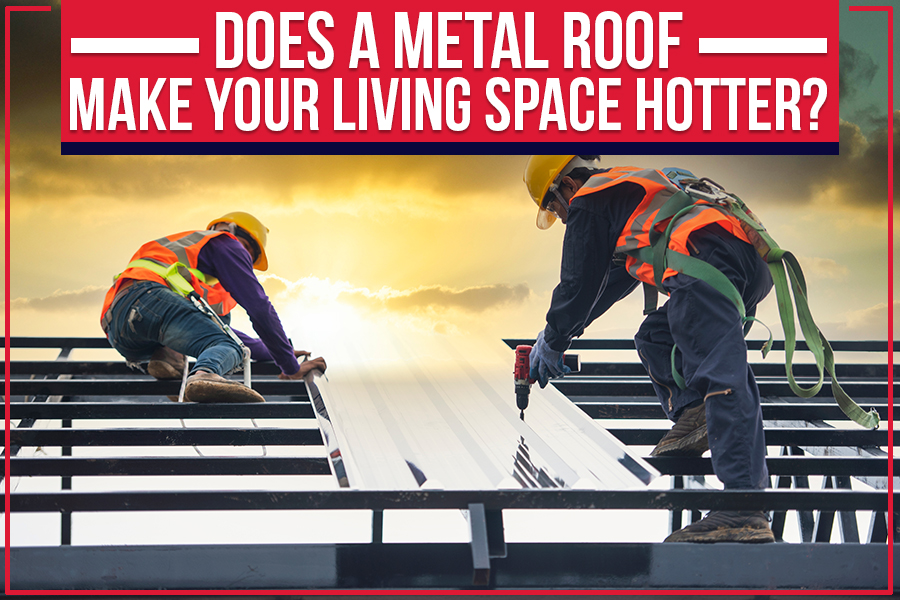Key Takeaways –
- Metal roofs are a popular roofing choice for many homeowners around Texas.
- Metal’s durable nature makes it weather resistant and protects you from the elements.
- However, many believe that metal roof installation invites unprecedented heat indoors.
- This is untrue, thanks to the metal roof’s thermal features.
- Metal roof reflects heat leading to better energy efficiency and lower power bills.
- Metal roof installation also offers other benefits, including its eco-friendly nature.
Like most people, the prospect of a metal roof worries you. It’s thin, noisy, and, worst of all, makes your house hotter! But is this true? Or are people just afraid of change? Today, we’ll discuss metal roofs and see once and for all if they make your house hotter. Stay tuned!
Summertime and the Livin’ is Hot – But is it Hotter with a Metal Roof?
Let’s start with some basics. Metal roofs have what’s known as a “low thermal mass.” This means they reflect heat rather than absorb it, like asphalt shingles. So, in theory, a metal roof should make your place hotter during summer.
But there’s more to consider than just the type of roof you have. The color of your roof can also make a difference. Darker colors absorb heat, while lighter colors reflect it. So, if you have a dark metal roof, it will absorb more heat and make your place hotter. But if you have a light-colored metal roof will reflect more heat and keep your place cooler.
Also, consider other factors like your attic’s ventilation space. If your attic is well-ventilated, the heat from the metal roof will dissipate and won’t make your place hotter. But an improperly ventilated attic will trap the heat from the metal roof and could make your place uncomfortably hot.
The Absorption Council’s Guide to Metal Roofs
Two other variables influence metal roofs’ heat absorbance: the finish type and the amount of sun exposure.
When it comes to finishes, there are three primary options: bare metal, Kynar 500 paint finish, and Hylar 5000 paint finish. All three have their benefits and drawbacks when it comes to heat absorbance.
Bare metal roofs are the most affordable option, but they don’t offer much protection from the sun’s rays. Kynar 500 paint finishes provide better reflectivity and absorbancy than bare metal roofs, but they’re more expensive. Hylar 5000 paint finishes offer the best protection from the sun’s rays but attach a higher price tag.
Another factor that influences how much heat a metal roof will absorb is the amount of sun exposure it gets. Metal roofs that are in direct sunlight will absorb more heat than those that are in shaded areas. Additionally, the mass of the roof also plays a role. A thicker roof will absorb less heat than a thinner one.
Factors Contributing to a Metal Roof’s Energy Efficiency
There are many factors influencing energy efficiency. The quality of materials you use and the skill of roof installation are two obvious factors influencing your metal roof’s energy efficiency. Here’s a look at other factors that effectively contribute to a metal roof’s tremendous energy efficiency.
- Reflective Surface – When the sun beats down on a traditional asphalt roof, it absorbs the heat and transfers it into your home. This causes your air conditioner to work overtime, keeping your place at a comfortable temperature. Metal roofs reflect sunlight away from your home, keeping the heat out and reducing the strain on your AC unit.
- Efficient Ventilation – Metal roofs allow hot air to rise and escape through ventilation systems while cooler air is drawn in from the eaves. This natural airflow helps keep your attic cooler, making your living space more comfortable. And since hot air rises, you’ll also see a reduction in energy costs in the wintertime.
- Durability – Metal roofs can last up to 50 years with minimal maintenance, which means you’ll save money in the long run. Metal roofs can withstand high winds, hail, and fire—giving you peace of mind during severe weather conditions.
Also, Read – The Addition of Attic in a Residential Roofing Inspection



